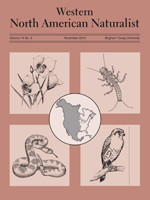Arctomecon humilis, a rare gypsophile of the extreme northeastern Mojave Desert, is restricted to a few isolated populations in Washington County, Utah, USA. At several times in the past quarter century, we have studied the breeding system and reproductive success of this endangered species, recorded its pollinators, and tested the feasibility of human-assisted gene flow by performing reciprocal crosses between 2 isolated “populations” approximately 4 km apart. Arctomecon humilis possessed a mixed breeding system in the population studied (Beehive Dome in 1988); some plants exhibited self-compatibility but produced significantly fewer fruit/flowers and seeds/fruit for geitonogamous self-pollinations than for cross-pollinations. Few fruits and seeds were produced in the absence of pollinators. The results of cross-pollination treatments did not differ from unassisted open-pollinations (controls), suggesting that pollinators were not limiting reproductive success. Our more recent results (2012) suggest that some populations may be more at risk than others. Although all 7 populations surveyed produced ≥70% fruits/flower, they differed significantly in fruit set and in average seed number/fruit and seed weight. Possible reasons for these differences (i.e., inbreeding, genetic load, insufficient mating types, pollinator scarcity, etc.), are all potentially important for conservation management and should be investigated. Over the past 2 decades, the pollinator community appears to have changed dramatically from one composed of specialist and generalist bees to one where pollination is presently being accomplished by generalist foragers alone. The health of one of these generalists, the honey bee Apis mellifera, is a current global concern, and its future presence as a pollinator of A. humilis is unclear. Our reciprocal crosses between the White Dome and Webb Hill populations provide support for our proposal that human-mediated gene flow through interpopulation cross-pollinations be undertaken every 5 years to increase the genetic variability of populations. We make several other recommendations for research that would improve the ability of land managers to conserve this species.
How to translate text using browser tools
1 November 2014
Reproduction and Pollination of the Endangered Dwarf Bear-Poppy Arctomecon humilis (Papaveraceae) across a Quarter Century: Unraveling of a Pollination Web?
Vincent J. Tepedino,
John Mull,
Terry L. Griswold,
Gerald Bryant
ACCESS THE FULL ARTICLE





